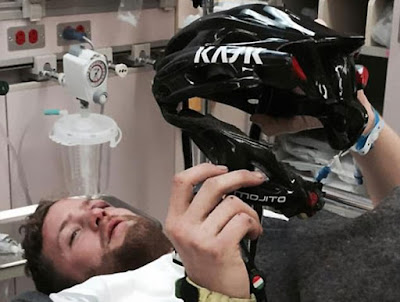Do we really need to wear helmets?
Nowadays the world is divided into countries with mandatory helmet laws, such as Finland, Argentina, New Zealand, the Republic of South Africa, Australia, and a few Canadian provinces, and the rest of the planet where only kids are required to wear helmet, if anyone at all.
One must ask: Is introducing mandatory helmet laws for all cyclists the right way to go or not? Medical experience clearly speaks in favour of helmets as they can prevent serious head injuries. From the general point of view, however, the answer is a little less straightforward. Does this sound like a blasphemy to you? What could possibly be wrong with introducing mandatory helmet laws for everyone who gets in the saddle?
Olympic champion Chris Boardman says it’s time for the cycling community to put the debate about mandatory cycle helmets to bed.
“I understand exactly why people feel so passionately about helmets or hi-vis. I understand why people wish to use them. But these actions seek to deal with an effect. I want to focus the debate on the cause, and campaign for things that will really make cycling safe. That is why I won’t promote high-vis and helmets – I won’t let the debate be drawn on to a topic that isn’t even in the top 10 things that will really keep people who want to cycle safe.”
Journalist and traffic expert Shaun Lopez-Murphy describes three theories of universally shared untruths about mandatory helmet use. The first one concerns excessive worry. Of the total number of cycling injuries, head injuries only comprise a small percentage. During a five-year period when Dr Teschke monitored helmet use in Canada, there were 633 cycling injuries per 100 million rides. Exactly one quarter, or 25% of all hospitalisations were due to head or face injury. That provoked arguments that considering biking without helmet as health-threatening is the same thing as thinking flying is dangerous because from time to time a plane crashes.
The second theory focuses on speed. Scientists call it risk compensation. A 2012 Norwegian survey suggests that cyclists who ride at higher speeds use helmets more often (as well as other sporting equipment, such as elastic garments, glasses, click-in shoes, and superlight bikes). They also have a much higher accident rate. A year later, this discovery was supported by a video analysis at a busy roundabout in Vancouver. It turned out that on average, cyclists wearing helmets went through the area at a 50% higher speed than those without a helmet. As every hypothesis has its denying counterpart, we must mention a recent study carried out by technical universities in Chemnitz and Dresden. Volunteers were equipped with cameras and had freedom to choose when and where they want to ride and if they want to use helmet or not. The results show that the majority of participants rode at a constant speed no matter if they were using a helmet or if they left it at home.
The last of the three theories focuses on general security in relation to the overall number of cyclists on roads. The scenario in many countries was similar: As mandatory helmet law was introduced, the number of cyclists started to decrease. In 2003, Peter Jacobsen discovered a direct proportion of the number of cyclists to their safety. The more cyclists on the roads, the more vigilant and considerate drivers are, which results in lower accident rate. Accordingly, when cyclists begin disappearing from the roads – for example because of mandatory helmet use – drivers tend to crash with them more often.
However, other regular cyclists take a different view. Alec Lom recounted in The Telegraph last year about how wearing a helmet when he had a low-speed collision with the front wheel of a car parked near his home ‘saved his life.’
He said, “I feel extremely fortunate to have escaped serious injury or even death. The precise circumstances of my tumble are now a little hazy, but one recollection remains crystal clear.
For now, though, whether or not to wear a helmet is entirely your decision, based on how you feel and how you want to be perceived.


Comments
Post a Comment